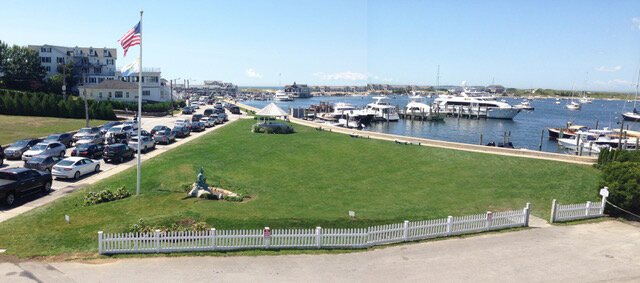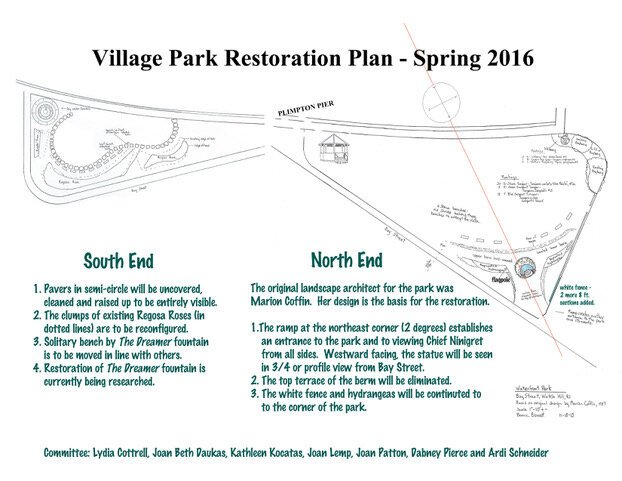
Village Park Restoration
Village Park History
Marion Coffin, a renowned landscape architect and Watch Hill resident, developed plans for the original park which were completed in 1936, including the placement of plantings, trees, pathways and statues: Chief Ningret statue (Enid Yandell, 1914-16) donated to the Village by Mrs. Clement C. Griscom in honor of her husband.
Chief Ninigret was originally placed on a horse trough at the intersection of Ninigret Avenue and Westerly Road, but with the evolution of the automobile and increased vandalism, the WHMLIS began looking for a new home for the statue. The spot was found as part of Marian Coffin’s plans placing the statue beside the harbor, facing the setting sun and Chief Ninigret’s homeland.
The Dreamer
The Dreamer, before.
The Dreamer, finished October 2017. Park Restoration Chairs Joan Beth Brown and Susie O’Connor (not pictured).
Ms. Coffin’s plans also included a drinking fountain on the opposite end of the Park which would become The Dreamer, commissioned by the WHMLIS from Sylvia Shaw Judson and donated by the Mrs. Rigley Watts in honor of her husband in 1940.
The Gazebo
In 1992, after various storms, the Park underwent an extensive restoration effort led by the WHMLIS, which included a Gazebo constructed in the Park with funds donated by the Lattner Family Foundation. The Gazebo is maintained by the WHMLIS with continued financial support from the Lattner family.
Chief Ninigret Restoration
At the time of the 100th Anniversary of Chief Ninigret in 2014 there was heightened interest, both with the WHMLIS and the Park Commission, in reestablishing the statue as a fountain with a pond and giving the area more prominence.
Following the concept of the original Coffin design, the committee met with landscape architects, plumbers, stonemasons, bronze sculptors, and fountain restorers in conjunction with the PC to establish a cohesive plan for the entire WH Village Park. This would include the removal of various plantings on both the south and north end of the park, the introduction of others, the continuation of the fence on the north end and the restoration of the Chief Ninigret and Dreamer statues. This was done in conjunction with new plantings around the Gazebo to show it to best advantage.
On October 30, 2015, Cherenzia & Associates assisted the committee by hoisting Chief Ninigret up in the air so that the water line to the fountains, which emit water through the mouths of the two fish held by the Chief, could be discovered. When it was seen under the boulder the realization of a restored Chief as a fountain was all but assured.
The many locations of Chief Ninigret.
Paris (1912-1914) Commissioned, Modeled and Cast
Lighthouse Road - September 2014, DedicatedNinigret Avenue/Westerly Road (1914-1936)
Statue a fountain in a trough for horsesNorth end of park (1936-1951)
Fountain with poolWHMLIS Lawn (1951-1966)
No longer a fountainSouth end of park (1966-1992)
North end of park (1992-2009/10)
Corner of north end of park (2010-present)
History of Chief Ninigret and the Village Park
In the mid 1930’s, the Watch Hill Fire District’s Park Commission, attempting to find the best use for its newly vacated property along Bay Street, suggested to the Watch Hill Improvement Society that they create a Memorial Park dedicated to its members. Renowned Landscape Architect, Watch Hill resident and Improvement Society member, Marian Cruger Coffin, agreed to develop a plan for the two triangular pieces of property adjacent to the bay. At the same time, the Fire District and Improvement Society were deliberating about what to do with the Chief Ninigret Statue. Commissioned by Mrs. Clement A. Griscom in 1913, the fountain statue was created by Enid Yandell, a student of Auguste Rodin, and cast by Alexis Rudier in Paris in 1914. The Statue was brought to the US and dedicated in the memory of Clement A. Griscom as a gift to the Village. Chief Ninigret had originally been placed on a horse trough at the intersection of Ninigret Avenue and Westerly Road where water flowed from the mouth of the two fish into the trough to water the horses. Over the years, with the decline of horse travel and the increase in automobile traffic, it was decided that a better place could be found for this beautiful statue. With the suggestion of some members, in 1935 Marian Coffin included the Chief Ninigret Statue in her plans for the Memorial Park surrounded by Memorial Benches. Marion’s Plan also called for a drinking fountain in the Southern end of the Park. The Improvement Society commissioned Sylvia Shaw to create what was to become “The Dreamer Statue” and donated by Mrs. Ridley Watts in memory of her late husband. The original plan, as well as more historical information regarding the Park, can be found on our website www.whmlis.org.
Over the years, the Watch Hill Improvement Society/Watch Hill Memorial Library and Improvement Society has worked together with the Watch Hill Parks’ Commission to maintain and enhance the Park, with everything from weekly maintenance by our members, additional memorial benches and stones, to monetary donations. In 1984, a major renovation of the Park was made possible thanks to the WHMLIS, the generosity of many members and friends, and included the addition of a Gazebo, thanks to the Lattner Family Foundation.
The Improvement Society has sought for many years to restore the Chief Ninigret Statue to its original status as a working fountain. As the 100th Anniversary of the Indian approached, we reached out to the Fire District to obtain permission to restore not only Chief Ninigret, but to develop a complete Plan for the restoration of the entire Park. At the end of the summer of 2015 the WHMLIS approved expenditures towards the restoration of the Chief and the beginning of the Park reclamation. Last Fall, a complete restoration plan, including the restoration of Chief Ninigret, reclaiming of the Memorial Benches from invasive rosa rugosa, replanting of hydrangea, repair work to the Dreamer Fountain, and reclaiming of stepping stones throughout the park, was approved by the Parks Commission. We’re excited to be beginning work to bring this plan to fruition over the coming years.









